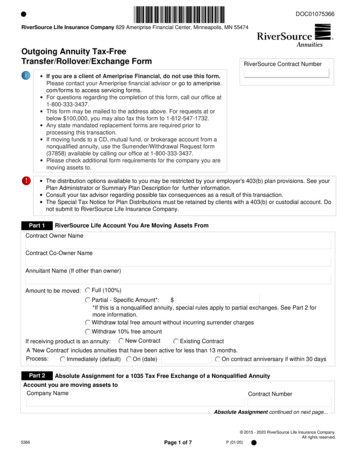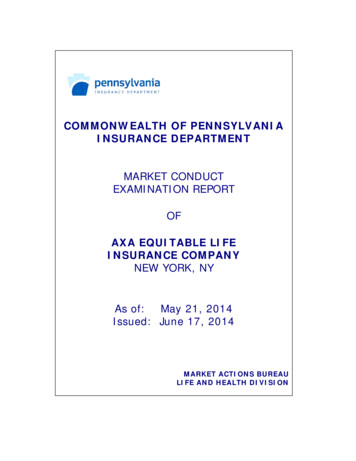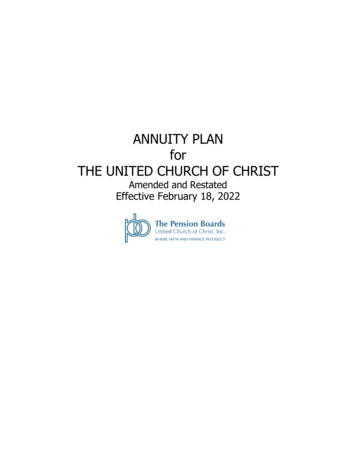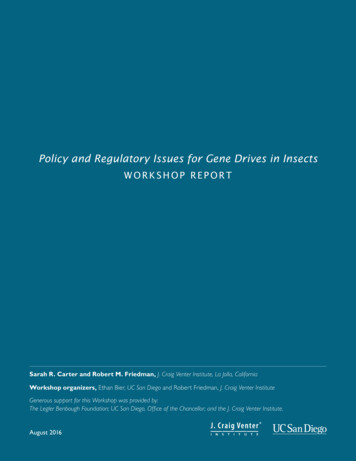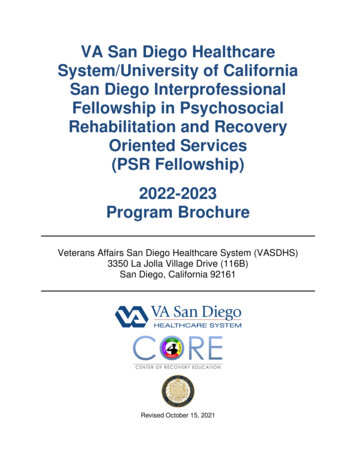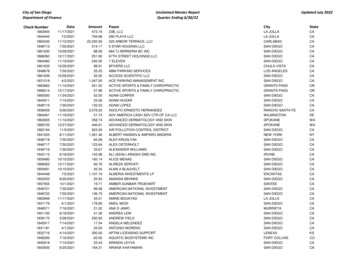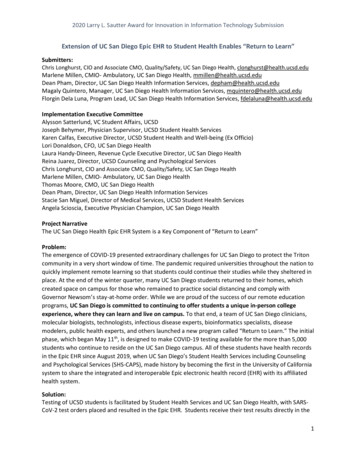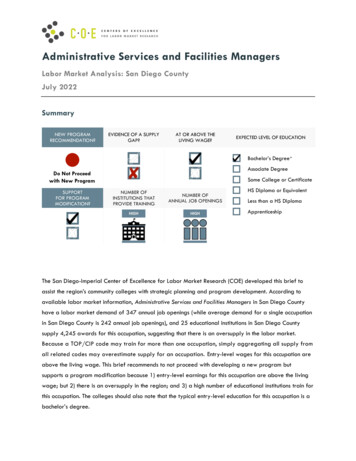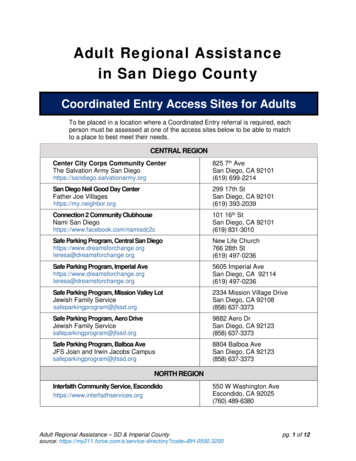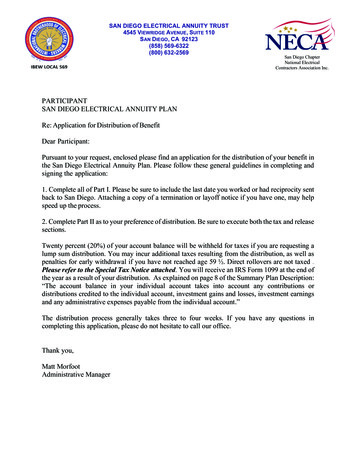
Transcription
SAN DIEGO ELECTRICAL ANNUITY TRUST4545 VIEWRIDGE AVENUE, SUITE 110SAN DIEGO, CA 92123(858) 569-6322(800) 632-2569San Diego ChapterNational ElectricalContractors Association Inc.PARTICIPANTSAN DIEGO ELECTRICAL ANNUITY PLANRe: Application for Distribution of BenefitDear Participant:Pursuant to your request, enclosed please find an application for the distribution of your benefit inthe San Diego Electrical Annuity Plan. Please follow these general guidelines in completing andsigning the application:1. Complete all of Part I. Please be sure to include the last date you worked or had reciprocity sentback to San Diego. Attaching a copy of a termination or layoff notice if you have one, may helpspeed up the process.2. Complete Part II as to your preference of distribution. Be sure to execute both the tax and releasesections.Twenty percent (20%) of your account balance will be withheld for taxes if you are requesting alump sum distribution. You may incur additional taxes resulting from the distribution, as well aspenalties for early withdrawal if you have not reached age 59 ½. Direct rollovers are not taxed .Please refer to the Special Tax Notice attached. You will receive an IRS Form 1099 at the end ofthe year as a result of your distribution. As explained on page 8 of the Summary Plan Description:“The account balance in your individual account takes into account any contributions ordistributions credited to the individual account, investment gains and losses, investment earningsand any administrative expenses payable from the individual account.”The distribution process generally takes three to four weeks. If you have any questions incompleting this application, please do not hesitate to call our office.Thank you,Matt MorfootAdministrative Manager
SPECIAL TAX NOTICE REGARDING PLAN PAYMENTSROLLOVER OPTIONS***************Start: 11Delta: 10Total: 4You are receiving this notice because all or a portion of a payment that you are eligible to receive from the Ohio Carpenters’ AnnuityPlan (the “Plan”) may be permitted to be rolled over to an IRA or an employer plan. This notice is intended to help you decide whetherto do such a rollover.This notice describes the rollover rules that apply to payments from the Plan that are not from a designated Roth account (a type ofaccount with special tax rules in some employer plans). If you also receive a payment from a designated Roth account in the Plan, youwill be provided a different notice for that payment, and the Plan administrator or the payor will tell you the amount that is being paidfrom each account.You may have the right to defer your distribution which is described in the “Right to Defer Distribution” section. Rules that apply tomost payments from a plan are described in the “General Information About Rollovers” section. Special rules that only apply in certaincircumstances are described in the “Special Rules and Options” section.RIGHT TO DEFER DISTRIBUTIONDepending on your vested account balance and the Plan provisions, you may be able to defer distribution of your account. If you areeligible to defer and elect to do so, you may continue to invest your account in the Plan’s investment options to the extent permitted bythe Plan. By deferring distribution you will have access to investment options that may not be generally available on similar termsoutside the Plan. Fees and expenses (including administrative or investment-related fees) outside the Plan may be different than thosethat apply to your account under the Plan. Refer to the Plan’s Summary Plan Description (“SPD”) or contact John Hancock atwww.mylife.jhrps.com or at 1.800.294.3575 to determine if the option to defer distribution is available to you. Your account will besubject to any restrictions and/or fees disclosed in the SPD, enrollment materials, and any required notices, copies of which youpreviously received. Additional copies as well as detailed Plan and investment information are available through John Hancock.GENERAL INFORMATION ABOUT ROLLOVERSHow can a rollover affect my taxes?You will be taxed on a payment from the Plan if you do not roll it over. If you are under age 59½ and do not do a rollover, you will alsohave to pay a 10% additional income tax on early distributions (unless an exception applies). However, if you do a rollover, you will nothave to pay tax until you receive payments later and the 10% additional income tax will not apply if those payments are made after youare age 59½ (or if an exception applies).Where may I roll over the payment?You may roll over the payment to either an IRA (an individual retirement account or individual retirement annuity) or an employer plan(a tax-qualified plan, section 403(b) plan, or governmental section 457(b) plan) that will accept the rollover. The rules of the IRA oremployer plan that holds the rollover will determine your investment options, fees and rights to payment from the IRA or employer plan(for example, no spousal consent rules apply to IRAs and IRAs may not provide loans). Further, the amount rolled over will becomesubject to the tax rules that apply to the IRA or employer plan.If your Plan provides for a designated Roth account, it may also allow in-plan Roth rollovers of amounts not currently held in thedesignated Roth account. See the section below titled “If your Plan permits a rollover to a designated Roth account in the Plan” for moreinformation.How do I do a rollover?There are two ways to do a rollover. You can do either a direct rollover or a 60-day rollover.If you do a direct rollover, the Plan will make the payment directly to your IRA or an employer plan. You should contact the IRA sponsoror the administrator of the employer plan for information on how to do a direct rollover.If you do not do a direct rollover, you may still do a rollover by making a deposit into an IRA or eligible employer plan that will accept it.You will have 60 days after you receive the payment to make the deposit. If you do not do a direct rollover, the Plan is required towithhold 20% of the payment for federal income taxes (up to the amount of cash and property received other than employer stock).This means that, in order to roll over the entire payment in a 60-day rollover, you must use other funds to make up for the 20%withheld. If you do not roll over the entire amount of the payment, the portion not rolled over will be taxed and will be subject to the10% additional income tax on early distributions if you are under age 59½ (unless an exception applies).How much may I roll over?If you wish to do a rollover, you may roll over all or part of the amount eligible for rollover. Any payment from the plan is eligible forrollover, except: Certain payments spread over a period of at least 10 years or over your life or life expectancy (or the lives or joint life expectancy ofyou and your beneficiary). Required minimum distributions after age 70½ (or after death). Hardship distributions. ESOP dividends. Corrective distributions of contributions that exceed tax law limitations. Loans treated as deemed distributions (for example, loans in default due to missed payments before your employment ends). Cost of life insurance paid by the Plan. Payments of certain automatic enrollment contributions requested to be withdrawn within 90 days of the first contribution. Amounts treated as distributed because of a prohibited allocation of S corporation stock under an ESOP (also, there will generally beadverse tax consequences if you roll over a distribution of S corporation stock to an IRA).Page 1 of 4
SPECIAL TAX NOTICE REGARDING PLAN PAYMENTSROLLOVER OPTIONS******The Plan administrator or the payor can tell you what portion of a payment is eligible for rollover.If I don’t do a rollover, will I have to pay the 10% additional income tax on early distributions?If you are under age 59½, you will have to pay the 10% additional income tax on early distributions for any payment from the Plan(including amounts withheld for income tax) that you do not roll over, unless one of the exceptions listed below applies. This tax is inaddition to the regular income tax on the payment not rolled over.The 10% additional income tax does not apply to the following payments from the Plan: Payments made after you separate from service if you will be at least age 55 in the year of the separation. Payments that start after you separate from service if paid at least annually in equal or close to equal amounts over your life or lifeexpectancy (or the lives or joint life expectancy of you and your beneficiary).Payments from a governmental defined benefit pension plan made after you separate from service if you are a public safetyemployee and you are at least age 50 in the year of the separation.Payments made due to disability.Payments after your death.Payments of ESOP dividends.Corrective distributions of contributions that exceed tax law limitations.Cost of life insurance paid by the Plan.Payments made directly to the government to satisfy a federal tax levy.Payments made up under a qualified domestic relations order (QDRO).Payments up to the amount of your deductible medical expenses.Certain payments made while you are on active duty if you were a member of a reserve component called to duty after September11, 2001 for more than 179 days.Payments of certain automatic enrollment contributions requested to be withdrawn within 90 days of the first contribution.If I do a rollover to an IRA, will the 10% additional income tax apply to early distributions from the IRA?If you receive a payment from an IRA when you are under age 59½, you will have to pay the 10% additional income tax on earlydistributions from the IRA, unless an exception applies. In general, the exceptions to the 10% additional income tax for earlydistributions from an IRA are the same as the exceptions listed above for early distributions from a plan. However, there are a fewdifferences for payments from an IRA, including: There is no exception for payments after separation from service that are made after age 55. The exception for qualified domestic relations orders (QDROs) does not apply (although a special rule applies under which, as partof a divorce or separation agreement, a tax-free transfer may be made directly to an IRA of a spouse or former spouse). The exception for payments made at least annually in equal or close to equal amounts over a specified period applies without regardto whether you have had a separation from service. There are additional exceptions for (1) payments for qualified higher education expenses, (2) payments up to 10,000 used in aqualified first-time home purchase, and (3) payments for health insurance premiums after you have received unemploymentcompensation for 12 consecutive weeks (or would have been eligible to receive unemployment compensation but for self-employedstatus).Will I owe State income taxes?This notice does not describe any State or local income tax rules (including withholding rules).SPECIAL RULES AND OPTIONSIf your payment includes after-tax contributionsAfter-tax contributions included in a payment are not taxed. If a payment is only part of your benefit, an allocable portion of your aftertax contributions is included in the payment, so you cannot take a payment of only after-tax contributions. However, if you have pre1987 after-tax contributions maintained in a separate account, a special rule may apply to determine whether the after-tax contributionsare included in a payment. In addition, special rules apply when you do a rollover, as described below.You may roll over to an IRA a payment that includes after-tax contributions through either a direct rollover or a 60-day rollover. Youmust keep track of the aggregate amount of the after-tax contributions in all of your IRAs (in order to determine your taxable income forlater payments from the IRAs). If you do a direct rollover of only a portion of the amount paid from the Plan and at the same time therest is paid to you, the portion directly rolled over consists first of the amount that would be taxable if not rolled over. For example,assume you are receiving a distribution of 12,000, of which 2,000 is after-tax contributions. In this case, if you directly roll over 10,000 to an IRA that is not a Roth IRA, no amount is taxable because the 2,000 amount not directly rolled over is treated as beingafter-tax contributions. If you do a direct rollover of the entire amount paid from the Plan to two or more destinations at the same time,you can choose which destination receives the after-tax contributions.If you do a 60-day rollover to an IRA of only a portion of a payment made to you, the after-tax contributions are treated as rolled overlast. For example, assume you are receiving a distribution of 12,000, of which 2,000 is after-tax contributions, and no part of thedistribution is directly rolled over. In this case, if you roll over 10,000 to an IRA that is not a Roth IRA in a 60-day rollover, no amountis taxable because the 2,000 amount not rolled over is treated as being after-tax contributions.If you miss the 60-day rollover deadlineGenerally, the 60-day rollover deadline cannot be extended. However, the IRS has the limited authority to waive the deadline undercertain extraordinary circumstances, such as when external events prevented you from completing the rollover by the 60-day rolloverdeadline. You may qualify for the self-certification procedure as outlined by the IRS at www.irs.gov/retirement-plans/retirement-plans-Page 2 of 4
SPECIAL TAX NOTICE REGARDING PLAN PAYMENTSROLLOVER y-rollover-requirement. Alternatively, you may file for a private letter ruling. Private letter rulingrequests require the payment of a nonrefundable user fee. For more information, see IRS Publication 590-A, Contributions to IndividualRetirement Arrangements (IRAs).If your payment includes employer stock that you do not roll overIf you do not do a rollover, you can apply a special rule to payments of employer stock (or other employer securities) that are eitherattributable to after-tax contributions or paid in a lump sum after separation from service (or after age 59½, disability or theparticipant’s death). Under the special rule, the net unrealized appreciation on the stock will not be taxed when distributed from thePlan and will be taxed at capital gain rates when you sell the stock. Net unrealized appreciation is generally the increase in the value ofemployer stock after it was acquired by the Plan. If you do a rollover for a payment that includes employer stock (for example, byselling the stock and rolling over the proceeds within 60 days of the payment), the special rule relating to the distributed employer stockwill not apply to any subsequent payments from the IRA or employer plan. The Plan administrator can tell you the amount of any netunrealized appreciation.If you have an outstanding loan that is being offsetIf you have an outstanding loan from the Plan, your Plan benefit may be offset by the amount of the loan, typically when youremployment ends. The loan offset amount is treated as a distribution to you at the time of the offset and will be taxed (including the10% additional income tax on early distributions, unless an exception applies) unless you do a 60-day rollover in the amount of the loanoffset to an IRA or employer plan. Recent law changes (Tax Cuts and Jobs Act) have extended the amount of time you have to roll overa loan offset from 60 days to until your tax filing due date (including extensions) for the year in which the loan offset amount occurred.This extension applies only if the offset was due to your termination from service or termination of the Plan.If you were born on or before January 1, 1936If you were born on or before January 1, 1936 and receive a lump sum distribution that you do not roll over, special rules for calculatingthe amount of tax on the payment might apply to you. For more information, see IRS Publication 575, Pension and Annuity Income.If your payment is from a governmental section 457(b) planIf the Plan is a governmental section 457(b) plan, the same rules described elsewhere in this notice generally apply, allowing you to rollover the payment to an IRA or an employer plan that accepts rollovers. One difference is that, if you do not do a rollover, you will nothave to pay the 10% additional income tax on early distributions from the Plan even if you are under age 59½ (unless the payment isfrom a separate account holding rollover contributions that were made to the Plan from a tax-qualified plan, a section 403(b) plan or anIRA). However, if you do a rollover to an IRA or to an employer plan that is not a governmental section 457(b) plan, a later distributionmade before age 59½ will be subject to the 10% additional income tax on early distributions (unless an exception applies). Otherdifferences are that you cannot do a rollover if the payment is due to an “unforeseeable emergency” and the special rules under “If yourpayment includes employer stock that you do not roll over” and “If you were born on or before January 1, 1936” do not apply.If you are an eligible retired public safety officer and your pension payment is used to pay for health coverage or qualifiedlong-term care insuranceIf the Plan is a governmental plan, you retired as a public safety officer, and your retirement was by reason of disability or was afternormal retirement age, you can exclude from your taxable income plan payments paid directly as premiums to an accident or healthplan (or a qualified long-term care insurance contract) that your employer maintains for you, your spouse, or your dependents, up to amaximum of 3,000 annually. For this purpose, a public safety officer is a law enforcement officer, firefighter, chaplain or member of arescue squad or ambulance crew.If you roll over your payment to a Roth IRAIf you roll over the payment from the Plan to a Roth IRA, a special rule applies under which the amount of the payment rolled over(reduced by any after-tax amounts) will be taxed. However, the 10% additional income tax on early distributions will not apply (unlessyou take the amount rolled over out of the Roth IRA within 5 years, counting from January 1 of the year of the rollover).If you roll over the payment to a Roth IRA, later payments from the Roth IRA that are qualified distributions will not be taxed (includingearnings after the rollover). A qualified distribution from a Roth IRA is a payment made after you are age 59½ (or after your death ordisability, or as a qualified first-time homebuyer distribution of up to 10,000) and after you have had a Roth IRA for at least 5 years.In applying this 5-year rule, you count from January 1 of the year for which your first contribution was made to a Roth IRA. Paymentsfrom the Roth IRA that are not qualified distributions will be taxed to the extent of earnings after the rollover, including the 10%additional income tax on early distributions (unless an exception applies). You do not have to take required minimum distributions froma Roth IRA during your lifetime. For more information, see IRS Publication 590-A, Contributions to Individual Retirement Arrangements(IRAs), and IRS Publication 590-B, Distributions from Individual Retirement Arrangements (IRAs).If your Plan permits a rollover to a designated Roth account in the PlanYou cannot roll over a distribution to a designated Roth account in another employer’s plan. However, you can roll the distribution overinto a designated Roth account in the distributing Plan. If you roll over a payment from the Plan to a designated Roth account in thePlan, the amount of the payment rolled over (reduced by any after-tax amounts directly rolled over) will be taxed. However, the 10%additional tax on early distributions will not apply (unless you take the amount rolled over out of the designated Roth account within the5-year period that begins on January 1 of the year of the rollover).If you roll over the payment to a designated Roth account in the Plan, later payments from the designated Roth account that arequalified distributions will not be taxed (including earnings after the rollover). A qualified distribution from a designated Roth account isa payment made both after you are age 59½ (or after your death or disability) and after you have had a designated Roth account in thePlan for at least 5 years. In applying this 5-year rule, you count from January 1 of the year your first contribution was made to thedesignated Roth account. However, if you made a direct rollover to a designated Roth account in the Plan from a designated RothPage 3 of 4
SPECIAL TAX NOTICE REGARDING PLAN PAYMENTSROLLOVER OPTIONS******account in a plan of another employer, the 5-year period begins on January 1 of the year you made the first contribution to thedesignated Roth account in the Plan or, if earlier, to the designated Roth account in the plan of the other employer. Payments from thedesignated Roth account that are not qualified distributions will be taxed to the extent of earnings after the rollover, including the 10%additional income tax on early distributions (unless an exception applies).If you are not a plan participantPayments after death of the participant. If you receive a distribution after the participant’s death that you do not roll over, thedistribution will generally be taxed in the same manner described elsewhere in this notice. However, the 10% additional income tax onearly distributions and the special rules for public safety officers do not apply, and the special rule described under the section “If youwere born on or before January 1, 1936” applies only if the participant was born on or before January 1, 1936.If you are a surviving spouse. If you receive a payment from the Plan as the surviving spouse of a deceased participant,you have the same rollover options that the participant would have had, as described elsewhere in this notice. In addition, ifyou choose to do a rollover to an IRA, you may treat the IRA as your own or as an inherited IRA.An IRA you treat as your own is treated like any other IRA of yours, so that payments made to you before you are age 59½ willbe subject to the 10% additional income tax on early distributions (unless an exception applies) and required minimumdistributions from your IRA do not have to start until after you are age 70½.If you treat the IRA as an inherited IRA, payments from the IRA will not be subject to the 10% additional income tax on earlydistributions. However, if the participant had started taking required minimum distributions, you will have to receive requiredminimum distributions from the inherited IRA. If the participant had not started taking required minimum distributions fromthe Plan, you will not have to start receiving required minimum distributions from the inherited IRA until the year theparticipant would have been age 70 ½.If you are a surviving beneficiary other than a spouse. If you receive a payment from the Plan because of theparticipant’s death and you are a designated beneficiary other than a surviving spouse, the only rollover option you have is todo a direct rollover to an inherited IRA. Payments from the inherited IRA will not be subject to the 10% additional income taxon early distributions. You will have to receive required minimum distributions from the inherited IRA.Payments under a qualified domestic relations order. If you are the spouse or former spouse of the participant who receives a paymentfrom the Plan under a qualified domestic relations order (QDRO), you generally have the same options the participant would have (forexample, you may roll over the payment to your own IRA or an eligible employer plan that will accept it). Payments under the QDROwill not be subject to the 10% additional income tax on early distributions.If you are a nonresident alienIf you are a nonresident alien and you do not do a direct rollover to a U.S. IRA or U.S. employer plan, instead of withholding 20%, thePlan is generally required to withhold 30% of the payment for federal income taxes. If the amount withheld exceeds the amount of taxyou owe (as may happen if you do a 60-day rollover), you may request an income tax refund by filing Form 1040NR and attaching yourForm 1042-S. See Form W-8BEN for claiming that you are entitled to a reduced rate of withholding under an income tax treaty. Formore information, see also IRS Publication 519, U.S. Tax Guide for Aliens, and IRS Publication 515, Withholding of Tax on NonresidentAliens and Foreign Entities.Other special rulesIf a payment is one in a series of payments for less than 10 years, your choice whether to make a direct rollover will apply to all laterpayments in the series (unless you make a different choice for later payments).If your payments for the year are less than 200 (not including payments from a designated Roth account in the Plan), the Plan is notrequired to allow you to do a direct rollover and is not required to withhold for federal income taxes. However, you may do a 60-dayrollover.If the Plan contains a mandatory cashout provision, unless you elect otherwise, a mandatory cashout (as described in the Plan’sSummary Plan Description (“SPD”)) will be directly rolled over to an IRA chosen by the Plan Administrator or the payor. A mandatorycashout is a payment from a plan to a participant made before age 62 (or normal retirement age, if later) and without consent, wherethe participant’s benefit does not exceed 5,000. Please refer to the Plan’s SPD to determine if the 5,000 threshold includes orexcludes any rollover contributions made to your account.You may have special rollover rights if you recently served in the U.S. Armed Forces. For more information, see IRS Publication 3,Armed Forces’ Tax Guide.You may roll over to an employer plan all of a payment that includes after-tax contributions, but only through a direct rollover (and onlyif the receiving plan separately accounts for after-tax contributions and is not a governmental section 457(b) plan). You can do a 60-dayrollover to an employer plan of part of a payment that includes after-tax contributions, but only up to the amount of the payment thatwould be taxable if not rolled over.FOR MORE INFORMATIONYou may wish to consult with the Plan administrator or payor, or a professional tax advisor, before taking a payment from the Plan. Also,you can find more detailed information on the federal tax treatment of payments from employer plans in: IRS Publication 575, Pensionand Annuity Income; IRS Publication 590-A, Contributions to Individual Retirement Arrangements (IRAs); IRS Publication 590-B,Distributions from Individual Retirement Arrangements (IRAs); and IRS Publication 571, Tax-Sheltered Annuity Plans (403(b) Plans).These publications are available from a local IRS office, on the web at www.irs.gov, or by calling 1-800-TAX-FORM.End 14Page 4 of 4
SAN DIEGO ELECTRICAL ANNUITY PLANDistribution DirectivePART I. PAYEE INFORMATIONPARTICIPANT DATAName (Last, First, MI)Social Security NumberAddressDate of BirthCityStateZipHome Phone Yes NoMarriedPrior Divorce(s)2YesPayeeNo Yes NoPAYEE DATA - Complete ONLY if Payee is other than Participant (i.e. Rollover, QDRO, etc.) Alternate Payee (QDRO) Beneficiary Other Trustee (Rollover) Other:Payee Name (Last, First, MI)SSN or Account No.FBO (for the benefit of)Date of Birth (if applicable)AddressCityStateZipPhone NumberTYPE OF DISTRIBUTION Final BalancePartialAmount: (Read and initial acknowledgment below.) Hardship (Special Rules Apply)Amount: I hereby acknowledge that by requesting a “Final Balance” in submitting this Directive, the Administrator will wait untilsuch time as contributions through the date I have indicated in the Qualifying Event. (initial)QUALIFYING EVENTDISTRIBUTION CODE Termination of ServiceDate: Return of Excess Deferrals RetirementDate: Required Minimum Distribution at Age 70½Name of Last Employer: Disability Divorce 2Date:Date: Death 1 Other:1Death Please provide administrator with copy of Death Certificate.2Divorce Must provide administrator with all copies of Judgment or Marital Settlement Agreements.Date:
FORM OF BENEFIT I elect to receive my benefit in a single sum, less tax withholdings. I elect to receive of my befit in a single sum less tax withholdings and a direct rollover of thebalance of my account to the IRA or qualified employer plan Named in Part 1, Payee Data. I elect a direct rollover of my account to the IRA or qualified employer plan as named in Part 1, Payee Data.ROLLOVER CERTIFICATION (REQUIRED FOR EMPLOYER PLANS ONLY)I certify that the plan named below is eligible to receive and will accept a direct rollover.Name of Payee/Plan DateSignature of Administrator/Broker:INCOME TAX WITHHOLDING NOTICE & ELECTION AND PARTICIPANT RELEASEWithholding of Federal income tax at a rate of 20% is automatic if your benefit is paid in the form of a singlesum or in installments over a period of less than 10 years and you did not elect to have the entire benefitdirectly rolled over into an IRA or other qualified employer plan. Applicable state income tax will be withheldfrom any distribution made to you unless you elect NOT to have state income tax withheld. If state laws arechanged to make withholding of state income tax mandatory for some distributions, as in the case of federalincome tax, any election NOT to have state income tax withheld will be disregarded.Do you want state income tax withheld from your distribution? Yes NoI have read and understand the Special Tax Notice attached. By signing below I consent to the distribution. If Iam married, my spouse and I both understand that we must consent to such distribution.SignatureDateI acknowledge that I am not and was not married dur
SAN DIEGO ELECTRICAL ANNUITY PLAN . Re: Application for Distribution of Benefit . Dear Participant: Pursuant to your request, enclosed please find an application for the distribution of your benefit in the San Diego Electrical Annuity Plan. Please follow these general guidelines in completing and signing the application: 1. Complete all of Part I.
